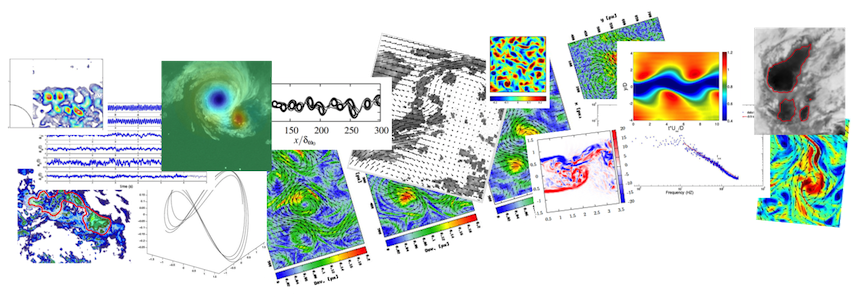Efficient fluid flow image data analysis procedures
Coarse-grid large eddy simulations in a wake flow. (P. Chandramouli, A. Gronskis D. Heitz, S. Laizet, E. Mémin) This study concerns mainly the PhD of Pranav Chandramouli (Fluminance). It aims at devising new subgrid terms ensuing from a stochastic representation of the flow. We have shown within this context that empirical estimates of the velocity fluctuations variance enable us to propose efficient and stable subgrid modelling for flow simulation at coarse resolution. This year we carefully assessed the results obtained by this turbulence model on two prototype flows: a wake flow and a channel flow. Both studies have led to conference articles and one article has been recently submitted to a journal. A close collaboration with Alejandro Gronskis on data assimilation strategy to estimate sensitive parameters of this model has been undertaken. Several results of this on-going work are promising.
Variational data assimilation for the reconstruction of 3D flows. (P. Chandramouli, A. Gronskis D. Heitz, S. Laizet, E. Mémin) The collaboration with Alejandro Gronskis and Dominique Heitz on the study of variational assimilation methods to estimate, from measurement data, the initial condition and the inflow/outflow conditions has been continued this year. Experiments on synthetic data have been conducted and we shall proceed soon to the method assessment on real data.
Variational data assimilation techniques to reconstruct 2D gappy velocity measurement data. (A. Gronskis D. Heitz, E. Mémin) In this axis, with Dominique Heitz and Alejandro Gronskis we have worked on the pressure reconstruction from the assimilation of incomplete flow measurement. The proposed technique provides accurate measurements of the lift and drag coefficients along time. A conference paper has been published and we are finalizing a journal paper that will be soon submitted.
Data assimilation of a Ginzburg-Landau Equation. (G. Artana, A. Camilleri, E. Mémin) Envelope or amplitude equations occur in many situations when the dynamics of a system develops on different, well separated, space-time scales. When dealing with experimental data, it is a challenging task to determine the coefficients of the amplitude equation formulated through a Ginzburg-Landau equation. In this study, we have formulated the coefficients estimation as a data assimilation problem. The technique improves significantly the results obtained by a previous method proposed in Chauve and Le Gal ( Chauve, M.P., Le Gal, P., Complex bi-orthogonal decomposition of a chain of coupled wakes, Physica, 1992) which applies to a set of successive snapshots of the flow field. Manuscripts describing our achievements are under preparation and we expect to submit them quite soon.
Analysis of Finite Time Lyapounov Exponents (FTLE) extraction for the stochastic representation under uncertainty of the flow dynamics. (G. Artana, Gisela Charo, E. Mémin, D. Sciamarella, V. Resseguier) In this axis, which corresponds to the PhD thesis of Gisela Charo (UBA) we have worked in collaboration with Valentin Resseguier on two different problems: the kinematics of streaklines, and Conservation equations along a streakline. For the first issue we derived the equations that describe the tangent of a streaklines at different points. These equations enable to understand the dynamics of discontinuities of streaklines (cut off of streaklines). For advection times lower than the characteristic time of the flow, we have proposed a criterion based on the Kurtosis of these cutoff events as an alternative to the traditional FTLE determination based on Cauchy Green tensor. This criterion enables to tackle conveniently problems of dimension larger than two. Concerning the second issue, We expressed the conservation equations established for a curvilinear system complying with with the streaklines (streakline coordinate system). In this system, we analyzed viscous flow conditions and the case in which viscosity effects are neglected under the hypothesis of data available only along the curve. One of the objectives was to establish an analogue of unsteady Bernoulli equation for the streakline system. We also considered cases in which data is available in two nearby streaklines.
Modeling of geophysical flows dynamics under location uncertainty. (Long Li, E. Mémin, D. Sciamarella) Models under location uncertainty are derived assuming that the flow can be decomposed in terms of an uncorrelated random component and a large-scale smooth velocity component. This decomposition requires considering a stochastic version of the material derivative, which introduces three additional terms: an advection correction due to turbulence inhomogeneity, an inhomogeneous and anisotropic diffusion and a multiplicative noise. After having systematically derived stochastic versions of geophysical flow dynamics under the Boussinesq approximation of small density fluctuations, we show how to devise quasi-geostrophic approximations of this random dynamics. Noises of small (much smaller than the Rossby number) and moderate amplitudes (of the order of the Rossby number) have been considered. Numerical experiments have shown the pertinence of this model for large-scale representations of the dynamics. Following the same framework we have studied a stochastic version of the celebrated Lorentz-63 model. The corresponding stochastic representation has been derived in the same way as the original model (ie from the Boussinesq representation of the Rayleigh-Benard convection) but with the stochastic expression of the material derivative. As opposed to classical diffusive systems, representative of the large-scale geophysical dynamics, the stochastic system has demonstrated its ability to reconstruct efficiently the deterministic system’s attractor.
Wall law expression within the modelling under uncertainty. (G. Artana, R. Lewandowski, E. Mémin, B. Pinier) In this on going study, corresponding to the PhD thesis of Benoit Pinier, we have shown that the modelling under uncertainty allowed us to take into account short time averaging and to modify the classical stationary wall law expression. The new law enables to significantly improve the correlation with the data when the averaging is led on short time periods, while it converges to the classical law when the time range tends to infinity. Comparisons with numerical data have been performed. We intend next to compare these new laws with real turbulent boundary







